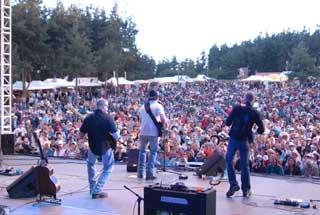Throughout my career as a professional guitarist I’ve played in all sorts of bands, and in all sorts of situations. I’ve played in rock bands, blues bands, jazz trio’s, and eight-piece country bands, and performed in night clubs, sports arenas, on flatbed trailers in a field, and at giant outdoor festivals. One of the biggest challenges of live performance has been the ongoing battle to achieve a palatable overall stage sound. As most musicians, myself included, use the same gear from one show to the next, this leaves the PA system, the sound engineer, and the natural  acoustic “space” of your performance as the variables that will regularly change.
acoustic “space” of your performance as the variables that will regularly change.
Let’s face it, most music performance venues are an afterthought. Whether it be a sports bar with a band in the corner, a tin roofed industrial building turned concert hall, or a 15,000 seat concrete sports arena moonlighting as a major concert venue, many of these situations simply don’t sound very inspiring. As a player in the band, I’m always trying to coax every ounce of sonic maximization out of every sound check or gig. But sometimes, no matter how much we keep tweaking monitor mixes, changing the angle or location of amplifiers, or notching annoying frequencies out of the PA, we just seem to wind up with a different version of mud. It is in these situations especially, that technique, concept, and style can have a huge bearing on the overall sound.
I saw an interview with Peter Frampton where he talked about a point early in his career when he transitioned from playing clubs and concert halls to sports arenas and stadiums. He mentioned how the sound was often less than great and that he adapted his songwriting style to work better in the context of “arena rock”. In the interview, he demonstrated this approach by playing a few simple power cords back to back and allowing the chords to ring openly. When I saw this interview, it not only reinforced a little of what I already knew, it got me thinking about how and  why this would make sense.
why this would make sense.
When sound is in an acoustic space that results in a loss of definition, some of the finite details of a musical performance become lost in the mud, often because of an overly exaggerated natural reverb and/or certain over accentuated frequencies. This is especially true in large cavernous buildings, or at over sized outdoor festivals. If you’ve ever played in these situations, you may have noticed that the ballads often tend to sound and feel better than the up-tempo songs. One of the reasons for this is because a slower tempo allows for longer note durations, and longer pauses, or more space, in between the notes. Playing in a larger physical space means that it takes longer for a note to develop and bounce off of a wall, and by playing long slow passages you are allowing these notes time to develop before bombarding them with the next note. You are playing into the inherently slow reaction time of a large or inefficient space and working with this handicap.
Now think of this phenomenon in reverse. You are playing a busy, up-tempo song in the same clumsy, nondescript acoustic environment. The bass player is playing a pedal of steady eighth notes on the low E, but because of the nature of the room, it just sounds like one big long note. The intricacies of the cymbal work seem to get lost, and the guitar solo doesn’t seem to cut through the mix. Needless to say, the vocalist is now having a difficult time singing over the roar. The room is just too loose to handle this many notes in rapid fire succession at a high volume, and turning the mix up or down doesn’t seem to help. When all else fails, simplify. Rather than just playing the exact pattern of the studio recording of a song, or your interpretation thereof, try adapting your part to fit the sonic inadequacies of a particular situation. Maybe quarter notes on the bass and a simpler pattern on the hi hat will help create a more open, and spacious mix. Perhaps simplifying the guitar part by leaving out certain rhythmic nuances that are getting lost anyway will create a better feel in the moment.
Back in the early 2000’s a friend of mine asked me to sub a gig for him on a national tour. His advice was to learn the material to the best of my abilities, but to play “big and spacey”. In the years since, I’ve worked hard at my ability to play into the sound of each “space” and have learned that not only is less more, quite often, less is better. Playing simply in live situations allows each note to have more meaning and also creates more space in the overall mix for the other instruments. And when all the players of a group work within this mindset it can also result in a more controlled, and often more inspired stage sound. So if you’re playing a show and it doesn’t sound good on stage, don’t just go on autopilot and accept that fate. Work towards finding a balance between the inadequate physical space of the venue, and the amount of perceived “space” in the music. Space has its own vibe. Space is beautiful.

One Response to Space is Beautiful
Leave a Reply
You must be logged in to post a comment.



great photo, the lights on the bridge and cityscape seem to form the outline of the body and neck of a guitar. Nice touch.